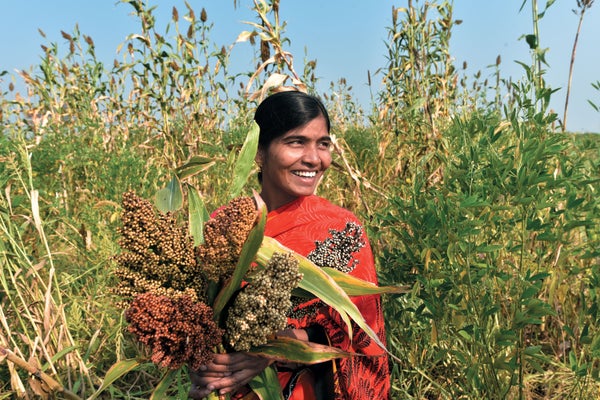No one in her village faced food shortages during the lockdowns, nor did they suffer from COVID-19, Moligeri Chandramma assured me through an interpreter in March 2021. A farmer in the drylands of southern India, she grows more than 40 species and varieties of crops—mostly native millets, rice, lentils and spices—on a bit more than a hectare of land. Chandramma is a member of the Deccan Development Society (DDS), a cooperative of nearly 5,000 Dalit (oppressed caste) and Adivasi (Indigenous) women whose remarkable integration of biodiversity conservation with agricultural livelihoods earned them the United Nations' prestigious Equator Award in 2019. Emerging from a situation of extreme malnutrition and social and gender discrimination in the 1980s, these farmers now enjoy food sovereignty and economic security. Beyond simply weathering the pandemic, in 2020 each family in DDS contributed around 10 kilograms of food grains to the region's relief effort for those without land and livelihoods.
On the other side of the world, six Indigenous Quechua communities of the Peruvian Andes govern the Parque de la Papa (Potato Park) in Pisac, Cusco, a mountainous landscape that is one of the original homelands of the potato. They protect the region as a "biocultural heritage" territory, a trove of biological and cultural riches inherited from ancestors, and conserve more than 1,300 varieties of potato. When I visited in 2008 with other researchers and activists, I was stunned into silence by the diversity.
"This is the outcome of 20 years' consistent work in relocalizing our food system, from a time when we had become too dependent on outside agencies for our basic needs," farmer Mariano Sutta Apocusi told Local Futures, an organization dedicated to strengthening communities worldwide, in August 2020. "Focusing on the local has helped us improve access to and affordability of a great diversity of food products—especially native potatoes, quinoa, kiwicha, other Andean tubers and maize, which we cultivate using Indigenous agroecological methods." The communities instituted strong health and safety measures when the pandemic hit, even as they harvested a bumper crop and distributed more than a ton of potatoes to migrants, the elderly and a shelter for abused teenage mothers in Cusco town.
On supporting science journalism
If you're enjoying this article, consider supporting our award-winning journalism by subscribing. By purchasing a subscription you are helping to ensure the future of impactful stories about the discoveries and ideas shaping our world today.
In Europe, many "solidarity economy" initiatives, which promote a culture of caring and sharing, swung into action when COVID-related lockdowns rendered massive numbers of people jobless. In Lisbon, Portugal, the social centers Disgraça and RDA69, which strive to re-create community life in an otherwise highly fragmented urban situation, reached out with free or cheap food to whoever needed it. They provided not only meals but also spaces where refugees, the unhoused, unemployed young people, and others who might otherwise have fallen through the cracks could interact with and develop relationships with better-off families, creating a social-security network of sorts. The organizers trusted those with adequate means to donate food or funds to the effort, strengthening the feeling of community in surrounding neighborhoods.
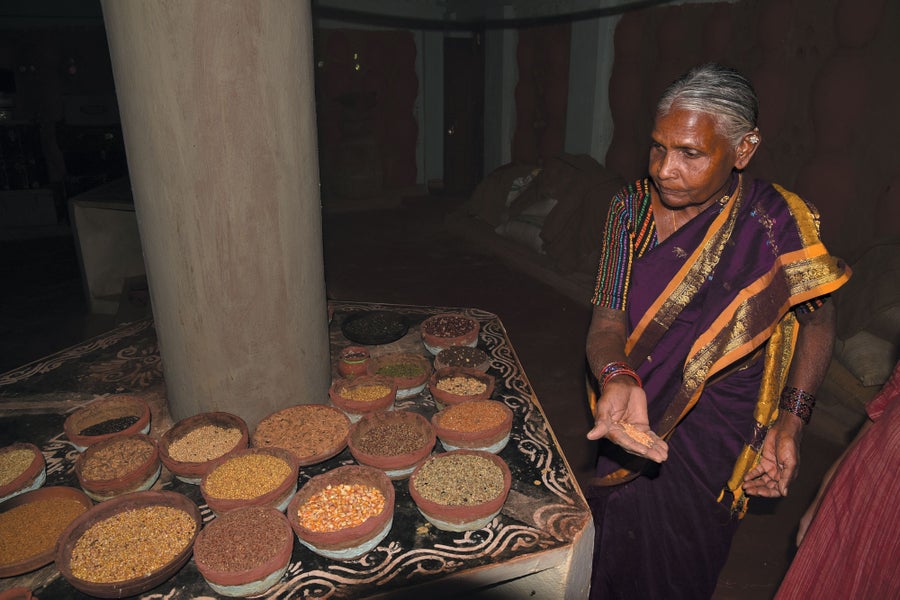
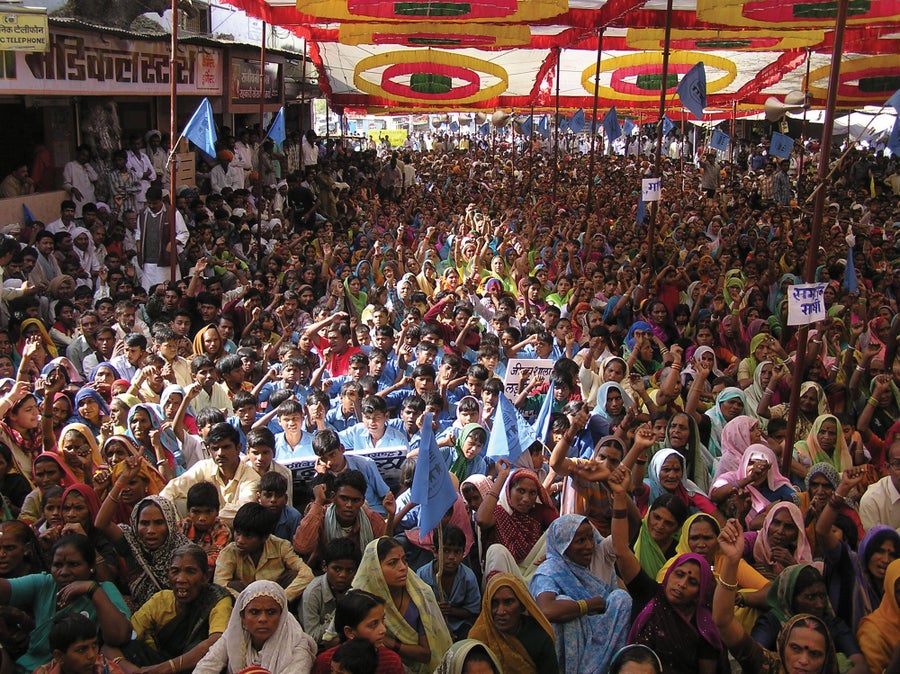
Moligeri Chandramma manages the DDS seed bank (top). It contains more than 70 species and varieties of crops. People gathered (bottom) in 2005 to mark 20 years of sustained protests against dam construction on the Narmada River. Credit: Ashish Kothari
The pandemic exposed the brittleness of a globalized economy that is advertised as benefiting everyone but in fact creates deep inequalities and insecurities. In India alone, 75 million people fell below the poverty line in 2020; globally, hundreds of millions who depend for their survival and livelihoods on the long-distance trade and exchange of goods and services were badly hit. Similar, albeit less extreme, dislocations also appeared during the 2008 financial crisis, when commodity speculation, along with the diversion of food grains to biofuel production, precipitated a steep rise in global grain prices, leading to hunger and food riots in many countries that depended on imported food. Threats to survival also emerge when war or other dislocations stop the movement of goods. During such crises, communities fare better if they have local markets and services and can provide their own food, energy and water while taking care of the less fortunate.
The value of these alternative ways of living goes far beyond their resilience during relatively short-term upheavals like the pandemic, however. As a researcher and environmental activist based in a "developing" country, I have long advocated that the worldviews of peoples who live close to nature be incorporated into global strategies for wildlife protection, such as at the International Union for Conservation of Nature and the United Nations' Convention on Biological Diversity. And in recent decades I have come to agree with critics of globalization such as social scientist and environmentalist Wolfgang Sachs who say that fending off calamities like biodiversity collapse will require not only environmental adaptations but also radical changes to the dominant economic, social and even political paradigms.
In 2014 a few of us in India initiated a process to explore pathways to a world in which people are at peace with one another and with nature. Five years later (and fortuitously, just before the pandemic hit), the endeavor grew into an international online network we called the Global Tapestry of Alternatives. These conversations and other research indicate that viable options, no matter where they are, tend to be based on self-reliance and solidarity.
Such values are at odds with globalization, which delivers to denizens of the Global North (the better off, no matter where we live) many things that we have come to regard as essential. In contrast to the promise of ever increasing material wealth that underpins our civilization, peoples who live near or beyond its margins have a multitude of visions for living well, each tailored to the specifics of their ecosystems and cultures. To walk away from the cliff edge of irreversible destabilization of the biosphere, I believe we must enable alternative structures, such as those of the Dalit farmers, the Quechua conservers and the Lisbon volunteers, to flourish and link up into a tapestry that ultimately covers the globe.
An Enlightening Journey
Growing up in India, where lifestyles that are intimately entwined with the natural environment survive in large pockets, unquestionably influenced my ideas of what constitutes true sustainability. In the 1970s, as a high school student who loved bird-watching in forests around Delhi, I joined classmates to demonstrate outside the Saudi Arabian embassy when some princes arrived in the country to hunt the (now critically endangered) Great Indian Bustard. Our protest, along with that of the Bishnoi community in Rajasthan, which traditionally protects these birds and other wildlife, embarrassed the Indian government into requesting that the hunters go home. Many of us went on to campaign for protection of the Delhi Ridge Forest, one of the world's biggest urban jungles. In 1979 we formed an environmental group to systematize our efforts. We called it Kalpavriksh, after a mythical tree that makes wishes come true; the name symbolized our growing awareness that nature gives us everything.
Our activism would teach us at least as much as we learned in school and college. While investigating the sources of Delhi's air pollution, for instance, we interviewed villagers who lived around a coal-fired power plant just outside the city. They turned out to be far worse affected by its dust and pollution than we city dwellers were—although they got none of its electricity. The benefits of the project flowed mainly to those who were already better off, whereas the disempowered experienced most of the harms.
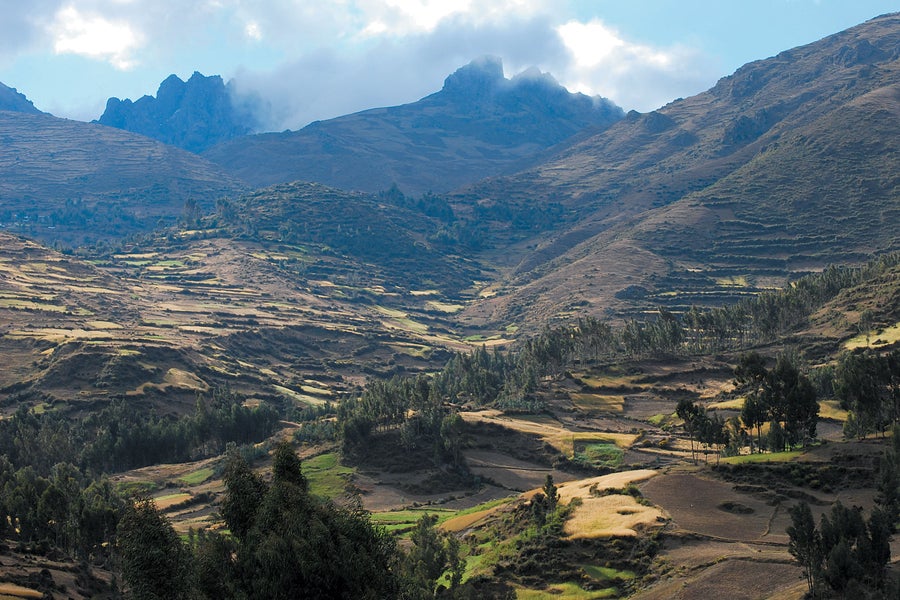
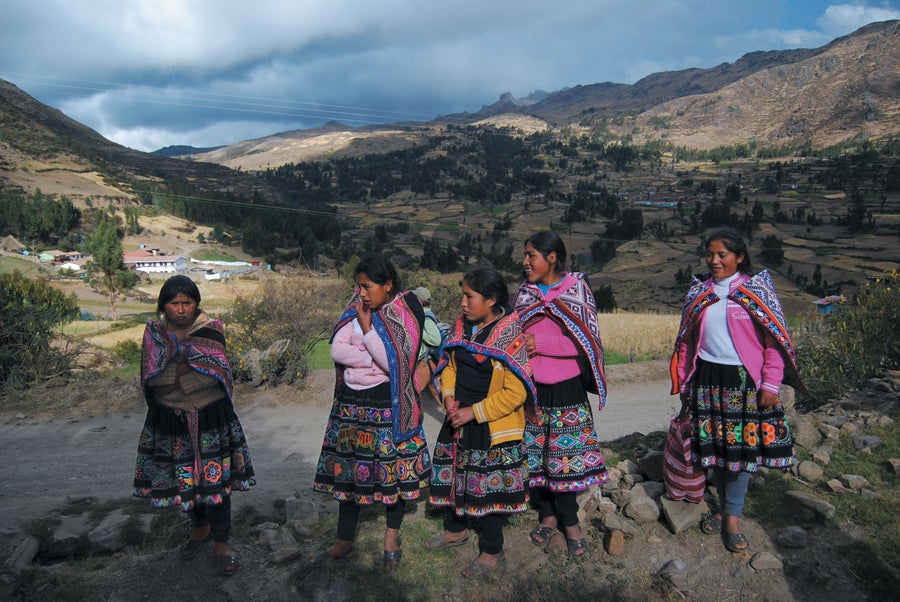
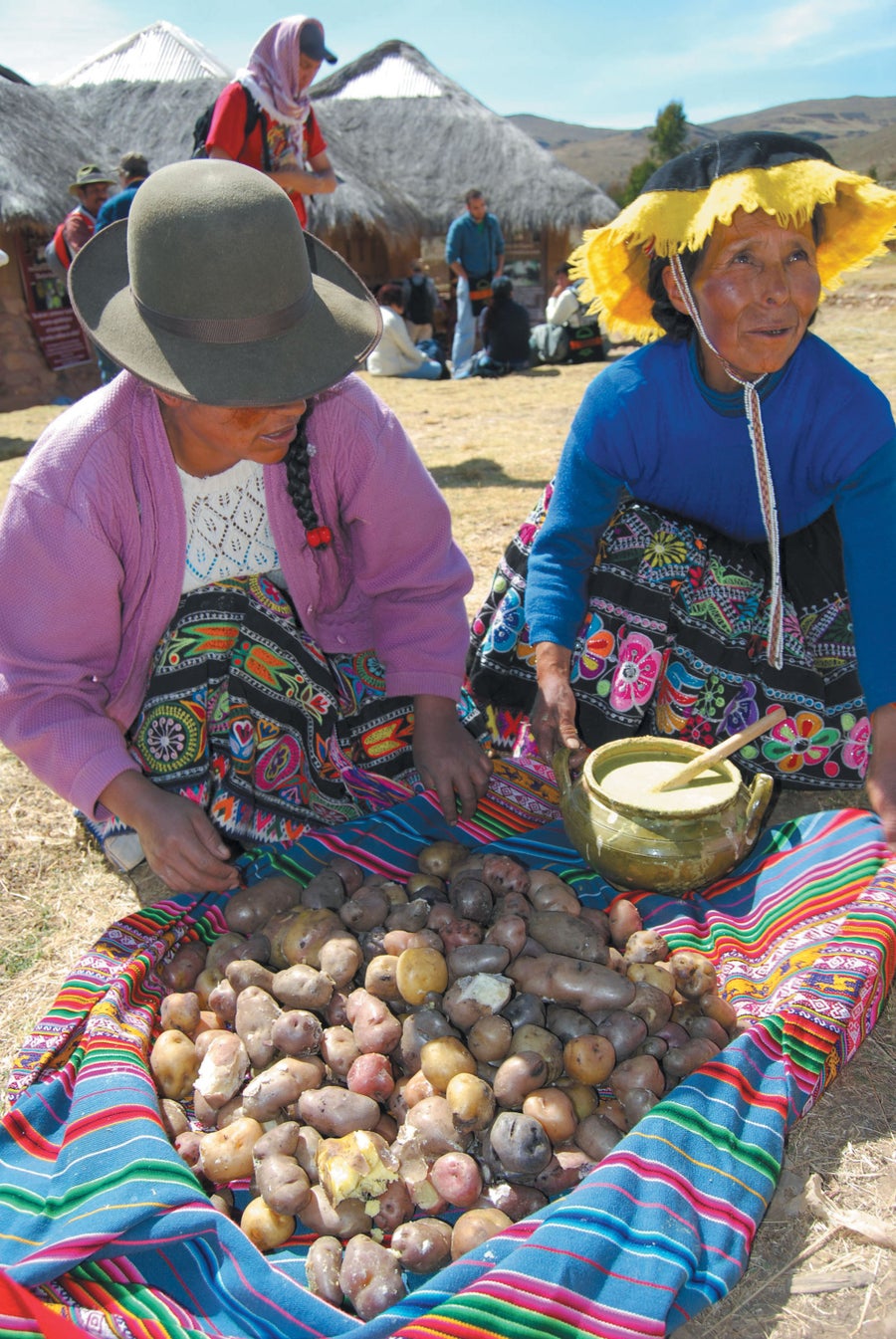
Parque de la Papa (top) in Peru is one of the original homelands of the potato. The Quechua Indigenous people (middle) govern the region as a “biocultural heritage” territory, conserving a remarkable diversity of potatoes (bottom). Credit: Ashish Kothari
In late 1980 we traveled to the western Himalayas to meet the protagonists of the iconic Chipko movement. Since 1973 village women had been protecting trees slated for logging by the forest department or by companies based in the Indian plains with their bodies. The deodars being felled, as well as the oaks, rhododendrons, and other species, were sacred, the women told us, as well as being essential for their survival. They provided cattle fodder, fertilizer and wild foods, and they sustained the local water sources. Even as an urban student, I could see the central role that rural women played in protecting the environment—as well as the injustice of distant bureaucrats making decisions with little concern for how they impacted those on the ground.
Soon after, my friends and I learned that 30 major dams were to be constructed on the Narmada River basin in central India. Millions worshipped the Narmada as a tempestuous but bountiful goddess—so pristine that the Ganga is believed to visit her every year to wash away her sins. Trekking, boating and riding buses along its length of 1,300 kilometers, we were dazzled by waterfalls plunging into spectacular gorges, densely forested slopes teeming with wildlife, fields of diverse crops, thriving villages and ancient temples, all of which would be drowned. We began to question the concept of development itself. Surely the destruction would far outweigh any possible benefits? Four decades later our fears have proved tragically true. Hundreds of thousands of displaced people still await proper rehabilitation, and the river downstream of the dams has become a trickle—enabling seawater to reach 100 kilometers inland.
Over the years I came to understand how powerful economic forces reach around the globe to intimately link social injustice with ecological destruction. The era of colonization and slavery vastly expanded the economic and military reach of some nation-states and their allied corporations, enabling the worldwide extraction of natural resources and exploitation of labor to feed the emerging industrial revolution in Europe and North America. Economic historians, anthropologists, and others have demonstrated how this painful history laid the foundation of today's global economy. Apart from driving irreversible ecological damage, this economic system robs many communities of access to the commons—to rivers, meadows and forests essential for their survival—while creating a dependence on external markets. The massive suffering during the pandemic has merely exposed these historical and contemporary fault lines.
During my wanderings over the decades and especially while researching a book with economist Aseem Shrivastava, I became aware of a far more hopeful trend. Across the country and indeed around the world, hundreds of social movements have been empowering the marginalized to wrest back control over their lives and livelihoods. In 2014 Kalpavriksh initiated a series of gatherings called Vikalp Sangam, or Confluence of Alternatives, where the drivers of these spirited efforts could come together, share ideas and experiences, and collaborate, helping to build a critical mass for change.
These interactions and eclectic readings gave me insights into a vital question I was investigating: What are the essential characteristics of desirable and viable alternatives? Happily, I was far from alone in this quest. At a degrowth conference in Leipzig in 2014, I was excited to hear Alberto Acosta, an economist and former politician from Ecuador, speaking on buen vivir, an Indigenous worldview founded on living well with one another and with the rest of nature. Although Acosta spoke no English and I spoke no Spanish, we tried excitedly to converse; subsequently, degrowth expert Federico Demario joined us and helped to translate. We decided to work on a compilation of thriving alternatives from around the world, jotting down 20 possible ideas on the back of an envelope. Later we roped in development critic Arturo Escobar and ecofeminist Ariel Salleh as co-editors of a volume we called Pluriverse. The number of entries expanded to more than 100.
Commonalities
Though dazzlingly diverse, the alternatives emerging worldwide share certain core principles. The most important is sustaining or reviving community governance of the commons—of land, ecosystems, seeds, water and knowledge. In 12th-century England, powerful people began fencing off, or "enclosing," fields, meadows, forests and streams that had hitherto been used by all. Enclosures by landlords and industrialists expanded to Europe and accelerated with the industrial revolution, forcing tens of millions of dispossessed people to either become factory workers or emigrate to the New World, devastating native populations. Imperial nations seized large portions of continents and reconfigured the economies of the colonies, extracting raw materials for factories, capturing markets for exports of manufactured goods and obtaining foods such as wheat, sugar and tea for the newly created working class. In this way, colonizers and their allies established a system of perpetual economic domination that generated the Global North and the Global South (the world of the marginalized, no matter where they live).
The wave of anticolonial movements in the first few decades of the 20th century, many of them successful, sparked fears that supplies of raw materials for industries and markets for finished goods of higher value would dry up. President Harry S. Truman responded by launching a program for alleviating poverty in what he described as "underdeveloped areas" with their "primitive and stagnant" economies. As detailed by ecologist Debal Deb, newly formed financial institutions controlled by the rich countries helped the ex-colonies "develop" along the path blazed by the West, providing the materials and energy sources for and creating markets for cars, refrigerators and other consumer goods. An integral aspect of development, as thus conceived, propagated and usually enforced by stringent conditions attached to loans from the World Bank and the International Monetary Fund, has been privatization or state confiscation of the commons to extract metals, oil and water.
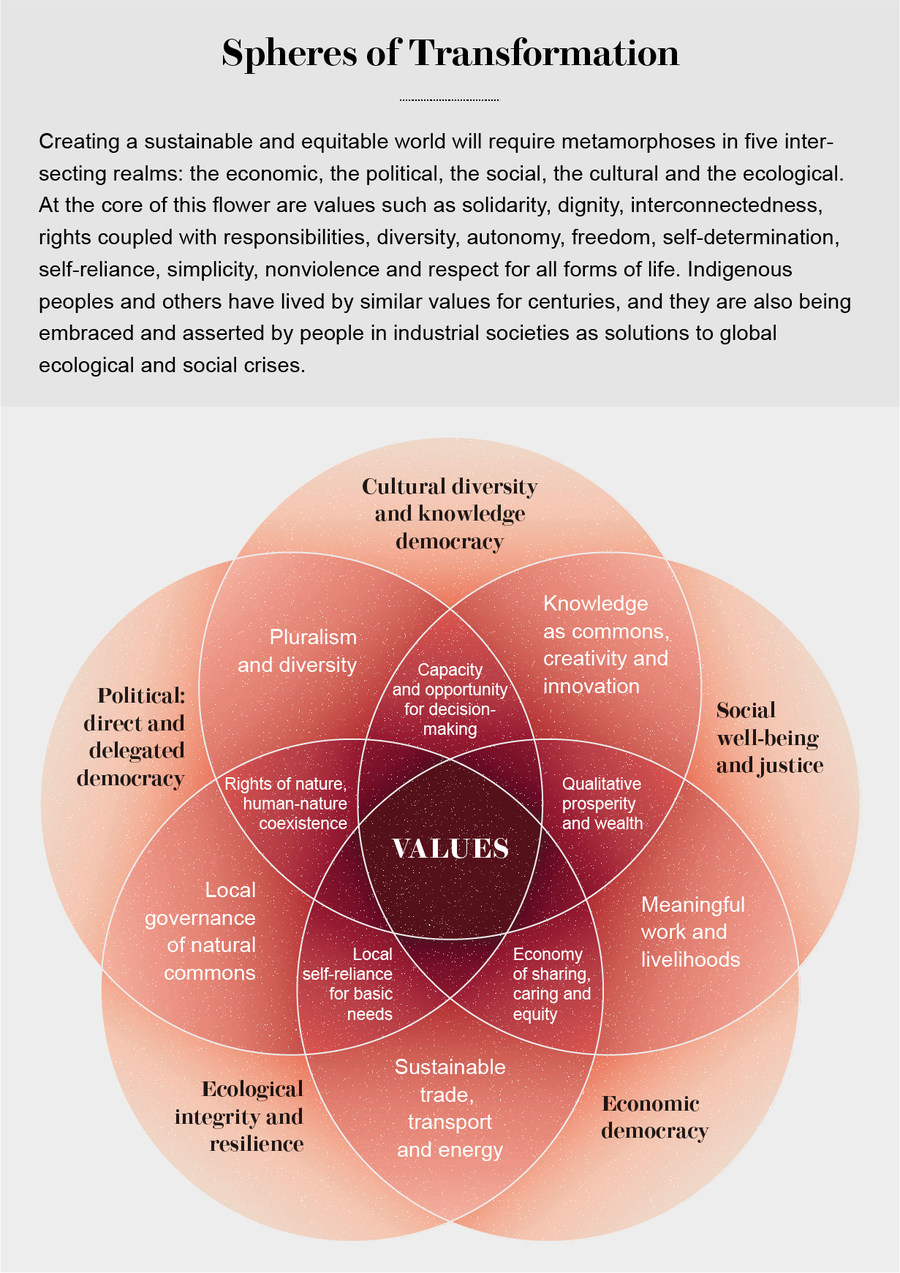
Credit: Federica Fragapane; Source: “Alternatives Transformation Format: A Process for Self-Assessment and Facilitation towards Radical Change,” prepared by Kalpavriksh for ACKnowl-EJ (chart reference)
As Elinor Ostrom, winner of the 2009 Nobel Memorial Prize in Economic Sciences, demonstrated, however, the commons are far more sustainably governed by the communities from which they are wrested than by the governments or corporations that claim them. This awareness has given rise to innumerable grassroots efforts to protect the surviving commons and reestablish control over others. What constitutes the commons has also expanded to include "physical and knowledge resources that we all share for everyone's benefit," explains sociologist Ana Margarida Esteves, who helps with the European Commons Assembly, an umbrella organization for hundreds of such endeavors.
Many of the efforts resemble the DDS and the Parque de la Papa in using community governance of commonly held resources to enhance agroecology (smallholder farming that sustains soil, water and biodiversity) and food sovereignty (control over all means of food production, including land, soil, seeds and the knowledge of how to use them). The food-sovereignty movement La Via Campesina, which originated in Brazil in 1993, now includes about 200 million farmers in 81 countries. Such attempts at self-reliance and community governance extend also to other basic needs, such as for energy and water. In Costa Rica, Spain and Italy, rural cooperatives have been generating electricity locally and controlling its distribution since the 1990s. And hundreds of villages in western India have moved toward "water democracy," based on decentralized harvesting of water and community management of wetlands and groundwater. Mobilizing people to sustain, build or rebuild local systems of knowledge is essential to such ventures.
Secure rights to govern the commons are also important. In the Ecuadorian Amazon, the Sapara Indigenous people fought hard to gain collective rights over their rainforest home. They are now defending it against oil and mining interests while developing a model of economic well-being that blends their traditional cosmovisions—ways of knowing, being and doing that are physically and spiritually linked to their environs—with new activities such as community-led ecotourism. Their income from tourism dropped during the pandemic, but their forests and community ethic provide almost all the food, water, energy, housing, medicines, enjoyment, health and learning they need. They are now offering online sessions on their cosmovisions, dream analysis and healing. I participated in such sessions in person in their Naku ecotourism camp in 2019. The virtual version is not as immersive but nonetheless represents an innovative adaptation to the circumstances.
Greening cities or making them more welcoming, as the Lisbon social centers do, also requires community-based governance and economies of caring and sharing. Across the Global South, development projects have driven hundreds of millions of people to cities, where they live in slums and work in hazardous conditions. Wealthy city dwellers could do their part by consuming less, which would reduce the extraction and waste dumping that displace people in faraway places. A spectrum of avenues toward more equitable and sustainable cities has emerged. These include, for example, the Transition Movement, which is attempting to regenerate the commons and make European cities carbon-neutral, and the municipalism movement, which is creating a network of Fearless Cities, including Barcelona, Naples, Madrid and Montreal, to provide secure environments for refugees and migrants, among other goals. Urban agriculture in Havana supplies more than half of the city's fresh food requirements and has inspired many other city farming initiatives around the world.
Five Petals
These initiatives point to the need for fundamental transformations in five interconnected realms. In the economic sphere, we need to get away from the development paradigm—including the notion that economic growth, as measured by gross domestic product (GDP), is the best means of achieving human goals. In its place, we need systems for respecting ecological limits, emphasizing well-being in all its dimensions and localizing exchanges to enable self-reliance—as well as good measures of these indicators. Bhutan has long experimented with gross national happiness as an index; the idea has spawned variants, such as New Zealand's recent focus on mental health and other such measures of progress.
We also need freedom from centralized monetary and financial control. Many experiments in alternative currencies and economies based on trust and local exchanges are underway. Perhaps the most innovative of these is "time banking," a system for swapping services founded on the principle that all skills or occupations merit equal respect. One can, for example, give a one-hour-long yoga lesson for credit that can be redeemed for an hour's work on bicycle repair. In many parts of the world, workers are seeking to control the means of production: land, nature, knowledge and tools. Some years back I visited Vio.Me, a detergent factory in Thessaloniki, Greece, which workers had taken over and converted from chemical to olive-oil-based and eco-friendly production, and where they had established complete parity in pay, regardless of what job the worker was doing. The slogan on their wall proclaimed: "We have no boss!"
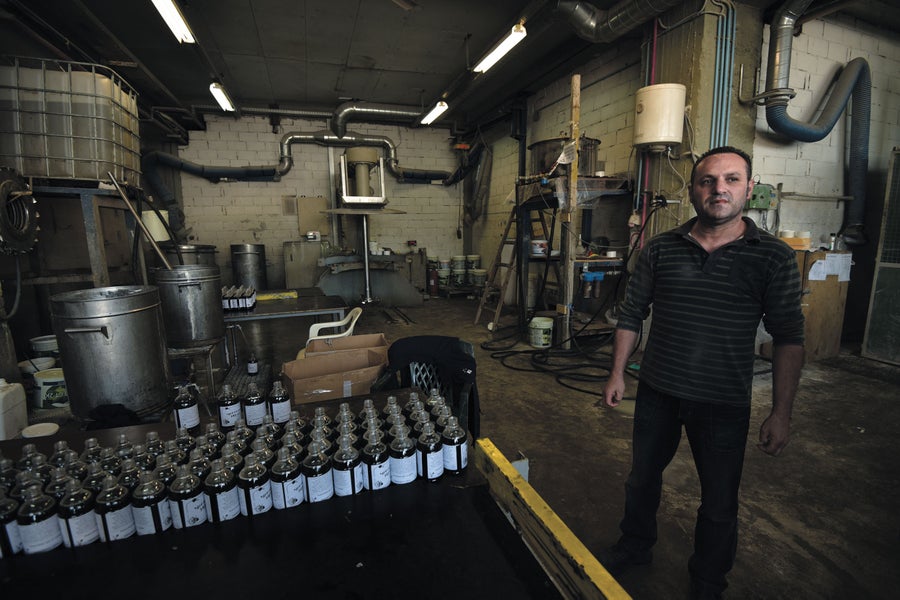
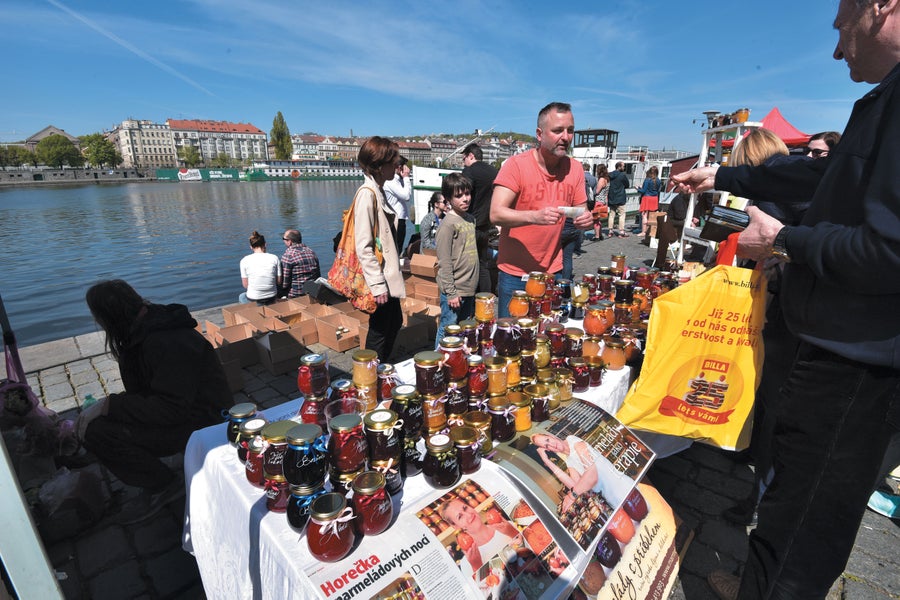
Workers such as Dimitris Koumatsioulis (top) collectively run Vio.Me, an eco-friendly detergent factory in Thessaloniki, Greece. In Prague, Czech Republic, people buy and sell locally (bottom) at a farmers' and producers' market. Credit: Ashish Kothari
In fact, work itself is being redefined. Globalized modernity has created a chasm between work and leisure—which is why we wait desperately for the weekend! Many movements seek to bridge this gap, enabling greater enjoyment, creativity and satisfaction. In industrial countries, people are bringing back manual ways of making clothes, footwear or processed foods under banners such as "The future is handmade!" In western India, many young people are leaving soul-killing routines in factories to return to handloom weaving, which allows them to control their schedules while providing a creative outlet.
In the political sphere, the centralization of power inherent in the nation-state, whether democratic or authoritarian, disempowers many peoples. The Sapara nation in Ecuador and the Adivasis of central India argue for a more direct democracy, where power resides primarily with the community. The state—insofar as it continues to exist—would then mainly help with larger-scale coordination while being strictly accountable to decision-making units on the ground. The ancient Indian notion of swaraj, literally translated as "self-rule," is particularly relevant here. It emphasizes individual and collective autonomy and freedom that are linked to responsibility for others' autonomy and freedom. A community that practices swaraj may not dam a stream, for example, if that threatens the water supply of downstream villages; its well-being cannot compromise that of others.
Such a notion of democracy also challenges the boundaries of nation-states, many of which are products of colonial history and have ruptured ecologically and culturally contiguous areas. The Kurdish people, for instance, are split among Turkey, Iran, Iraq and Syria. For three decades they have struggled to achieve autonomy and direct democracy based on principles of ecological sustainability and women's liberation—and without borders dividing them. And Indigenous groups in Mexico collectively identifying as Zapatistas have for more than three decades asserted an autonomous region based on similar principles.
Moving toward such radical democracy would suggest a world with far fewer borders, weaving tens of thousands of relatively autonomous and self-reliant communities into a tapestry of alternatives. These societies would connect with one another through "horizontal" networks of equitable and respectful exchange, as well as through "vertical" but downwardly accountable institutions that manage processes and activities across the landscape.
Several experiments in bioregionalism at large scales are underway, although most remain somewhat top-down in their governance. In Australia, the Great Eastern Ranges Initiative seeks to coordinate the conservation of ecosystems across 3,600 kilometers while sustaining livelihoods and community health. And a project spanning six countries aims to conserve as a World Heritage Site the Qhapaq Ñan, a 23,000-kilometer network of roads in the Andes built by the Inca Empire, along with its related cultural, historical and environmental heritage.
Local self-governance may, of course, be oppressive or exclusionary. The intensely patriarchal and casteist traditional village councils in many parts of India and the xenophobic antirefugee approaches of the right wing in Europe illustrate this drawback. A third crucial sphere of transformation is therefore social justice, encompassing struggles against racism, casteism, patriarchy, and other traditional or modern forms of discrimination and exploitation. Fortunately, success in defying the dominant economic system often goes hand in hand with victories against discrimination, such as Dalit women farmers' shaking off centuries of caste and patriarchal oppression to achieve food sovereignty.
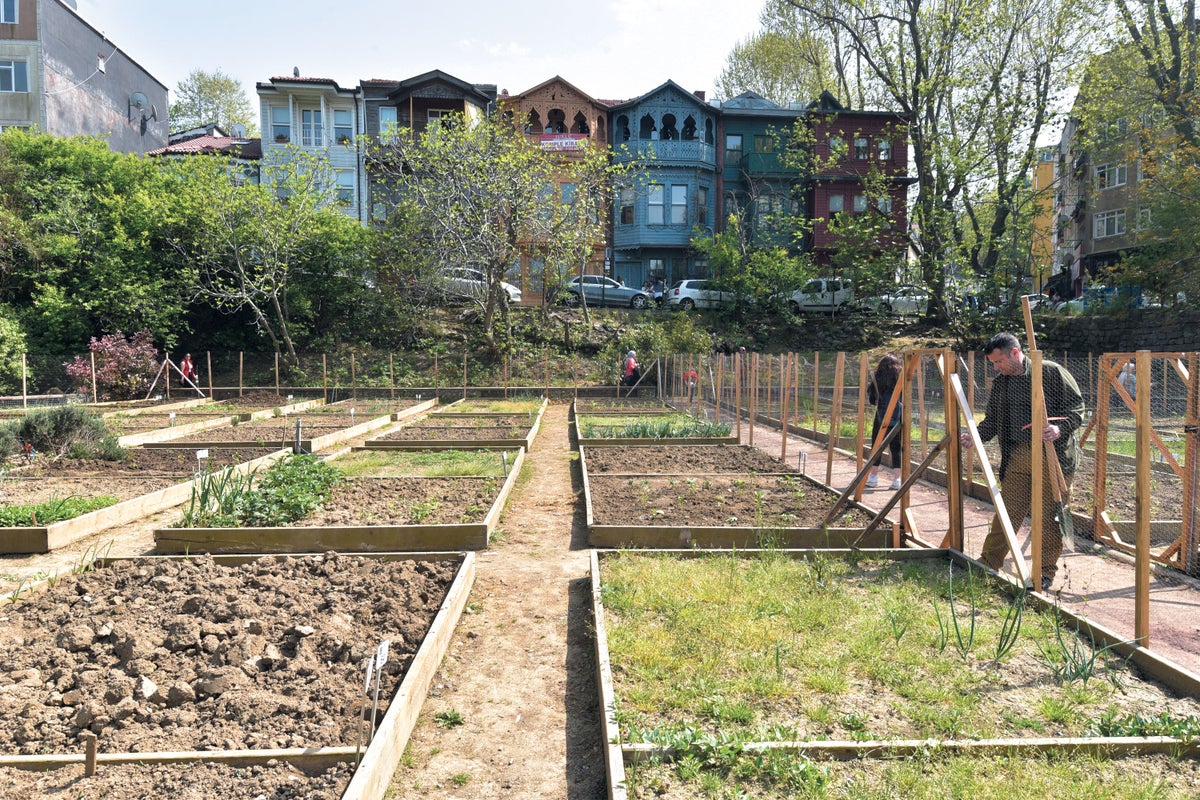
Kuzguncuk Bostan, an urban commons in Istanbul, Turkey, enables city dwellers to collectively grow their own fruit, vegetables and other produce.
Credit: Ashish Kothari
Political autonomy and economic self-reliance need not mean isolationism and xenophobia. Rather cultural and material exchanges that maintain local self-reliance and respect ecological sustainability would replace present-day globalization—which perversely allows goods and finances to flow freely but stops desperate humans at borders. This kind of localization would be open to people in need; refugees from climate change or war would be welcomed, as in the network of Fearless Cities in Europe. Both grounded practice and shifts in policy could help transit toward such a system. Necessary, of course, are attempts to rebuild societies in regions of strife so that people do not have to flee from them.
Radical change also necessitates transformations in a fourth sphere: that of culture and knowledge. Globalization devalues languages, cultures and knowledge systems that do not adapt to development. Several movements are confronting this homogenizing tendency. The Sapara nation is trying to resuscitate its almost extinct language and preserve its knowledge of the forest by bringing these into the curriculum of the local school, for instance. Many communities are "decolonizing" maps, putting back their own place names and defying political borders. Even the colonial-era Mercator projection used to generate the familiar world map is being upended. (Only recently did I realize that Africa is large enough to contain Europe, China, the U.S. and India put together.) Increasingly, traditional and modern sciences are collaborating to help solve humankind's most vexing problems. The Arctic Biodiversity Assessment, for example, involved cooperation among Indigenous peoples and university scientists to tackle climate change.
One problem is that present-day educational institutions train graduates who are equipped to serve and perpetuate the dominant economic system. People are bringing community and nature back into spaces of learning, however. These efforts include forest schools in many parts of Europe that provide children with hands-on learning in the midst of nature, the Zapatista autonomous schools that teach about diverse cultures and struggles, and the Ecoversities Alliance of centers of higher learning around the world that enable scholars to seek knowledge across the boundaries that typically separate academic disciplines.
The most important sphere of transformation, however, is the ecological—recognizing that we are part of nature and that other species are worthy of respect in their own right. Across the Global South, communities are leading efforts to regenerate degraded ecosystems and wildlife populations and to conserve biodiversity. Tens of thousands of "territories of life" are being governed by Indigenous or other local communities, for example. These include locally managed marine areas in the South Pacific, Indigenous territories in Latin America and Australia, community forests in South Asia, and the Ancestral Domain territories in the Philippines. Also noteworthy is recent legislation or court judgments in several countries asserting that rivers, for example, enjoy the same protections as people. The United Nations' 2009 Declaration on Harmony with Nature is an important milestone toward such a goal.
Values
I am often asked how one scales up successful alternatives. It would be self-defeating, however, to try to either scale up or replicate a DDS or a Parque de la Papa. The essence of this approach is diversity: the recognition that every situation is different. What people can do—and this, indeed, is how successful initiatives spread—is understand the underlying values and apply these in their own communities while networking with like ventures to spread the impact.
The Vikalp Sangam process has identified the following values as crucial: solidarity, dignity, interconnectedness, rights and responsibilities, diversity, autonomy and freedom, self-reliance and self-determination, simplicity, nonviolence and respect for all life. Around the world both ancient and modern worldviews that are focused on life articulate similar principles. Indigenous peoples and other local communities have lived by worldviews such as buen vivir, swaraj, ubuntu (an African philosophy that sees the well-being of all living things as interconnected) and many other such ethical systems for centuries and are reasserting them. Simultaneously, approaches such as degrowth and ecofeminism have emerged from within industrial societies, seeding powerful countercultures.
At the heart of these worldviews lies a simple principle: that we are all holders of power, and in the exercise of this power, we not only assert our own autonomy and freedom but also are responsible for ensuring the autonomy of others. Such a swaraj merges with ecological sustainability to create an eco-swaraj, encompassing respect for all life.
Clearly, such fundamental transformations face a deeply entrenched status quo that retaliates violently wherever it perceives a threat. Hundreds of environmental defenders are murdered every year. Another serious challenge is the unfamiliarity many people in the Global North have with ideals of a good life beyond the American dream. Even so, the fact that many progressive initiatives are thriving and new ones are sprouting suggests that a combination of resistance and constructive alternatives does stand a chance.
The COVID pandemic presented humankind with a choice: Will we head right back toward some semblance of the old normal, or will we adopt new pathways out of global ecological and social crises? To maximize the likelihood of the latter, we need to go well beyond the Green New Deal approaches in the U.S., Europe, and elsewhere. Their intense focus on the climate crisis and worker rights is valuable, but we also need to challenge unsustainable consumption patterns, glaring inequalities and the need for centralized nation-states.
Truly life-sustaining recoveries would emphasize all the spheres of eco-swaraj, arrived at via four pathways. One is the creation or revival of dignified, secure and self-reliant livelihoods for two billion people based on collective governance of natural resources and small-scale production processes such as farming, fisheries, crafts, manufacturing and services. Another is a program for regeneration and conservation of ecosystems, led by Indigenous peoples and local communities. A third is immediate public investments in health, education, transportation, housing, energy and other basic needs, planned and delivered by local democratic governance. Finally, incentives and disincentives to make production and consumption patterns sustainable are crucial. These approaches would integrate sustainability, equality and diversity, giving everyone, especially the most marginalized, a voice. A proposal for a million climate jobs in South Africa is of this nature, as is a feminist economic recovery plan for Hawaii and several other proposals for social justice in other countries.
None of this will be easy, but I believe it is essential if we are to make peace with Earth and among ourselves.
